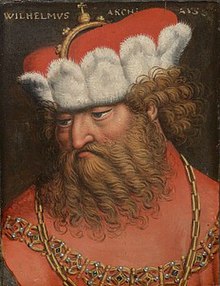William of Austria
| William the Courteous | |
|---|---|
| Duke of Austria | |

Historic portrait by Anton Boys (about 1580)
|
|
| Duke | 1386–1406 |
| Predecessor | Leopold III |
| Successor | Leopold IV |
| Spouse(s) | Joanna II of Naples |
| Noble family | House of Habsburg |
| Father | Leopold III, Duke of Austria |
| Mother | Viridis Visconti |
| Born |
c. 1370 Vienna, Austria |
| Died | 15 July 1406 (age 36) Vienna |
| Buried | Ducal Crypt in St. Stephen's Cathedral, Vienna |
William (c. 1370 – 15 July 1406), known as William the Courteous (German: der Freundliche), a member of the House of Habsburg, was Duke of Austria from 1386. As head of the Leopoldian line, he ruled over the Inner Austrian duchies of Carinthia, Styria and Carniola as well as the County of Tyrol and Further Austria from 1396 until his death.
Born in Vienna, William was the oldest son of Duke Leopold III of Austria (1351–1386) and his consort Viridis Visconti (1352–1414), a daughter of Lord Bernabò of Milan. Leopold III had already acted as regent over the Tyrol and the Further Austrian possessions in Swabia; in 1379 he signed the Treaty of Neuberg with his elder brother Duke Albert III, whereupon he also received the Inner Austrian lands.
At the age of 14, William was betrothed to the Anjou princess Hedwig (Jadwiga; 1373–1399), the youngest daughter of King Louis I of Hungary, who had also become King of Poland in 1370. This was one of the first attempts of the Habsburgs to extend their dominions by marrying heiresses, as Louis intended his elder daughter Mary and her fiancé Sigismund of Luxembourg to succeed in Poland, while Jadwiga was designated heir to the Kingdom of Hungary. When King Louis died in 1382, Mary succeeded in Hungary. However, the Polish nobles rejected Mary and Sigismund, and instead chose Jadwiga as queen regnant. They also repudiated her betrothal to William and enforced the break-up of the engagement.
...
Wikipedia
